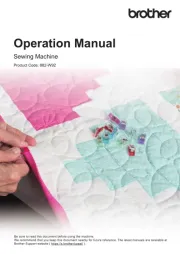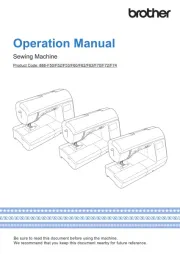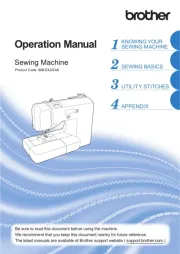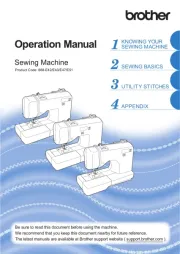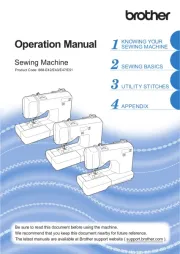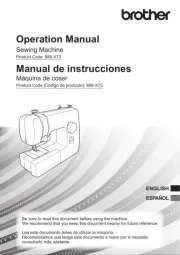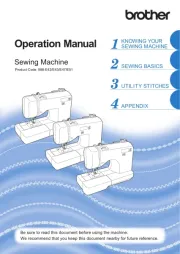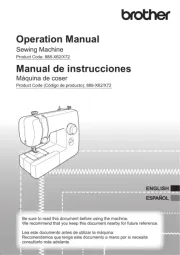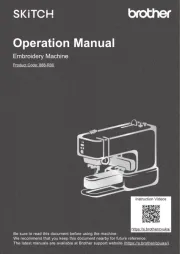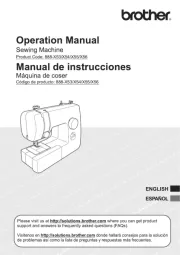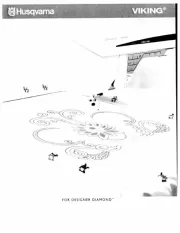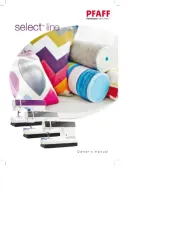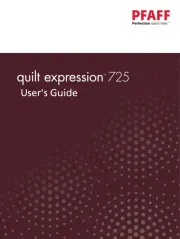
●Always turn off the machine before
you change the needle. Otherwise,
injuries may occur if the foot
controller is accidentally pressed
and the machine starts sewing.
●Only use sewing machine needles
for home use. Other needles may
bend or break and cause injury.
●Never sew with a bent needle. A
bent needle will easily break and
●Make sure you insert the needle until it
touches the stopper, and securely tighten
the needle clamp screw with a screwdriver,
otherwise the needle may break or the
●Before replacing the needle, place
fabric or paper under the presser foot
to prevent the needle from falling into
the hole in the needle plate.
Turn the screw counterclockwise.
it in that position while
you lightly push the foot
• To sew forward, release
Changing the presser foot
Use a piece of fabric and
thread tension and stitch
foot lever. Using the needle as a pivot, turn
the fabric, lower the presser foot lever, and
Stitching cylindrical pieces
Slide the part that you wish
●When you are nished with free-arm sewing,
install the at bed attachment back in its
●Always turn off the machine before you change
the presser foot. If you leave the power on and
step on the controller, the machine will start and
●Always use the correct presser foot for the
stitch pattern you have chosen. If you use the
wrong presser foot, the needle may strike the
presser foot and bend or break, and may cause
●Only use presser feet that have been designed
to be used with this machine. Using any other
presser foot may cause accident or injury.
If the fabric does not t
foot lever even higher to
bring the presser foot to its
If fabric more than 6 mm (15/64 inch) thick is
sewn or if the fabric is pushed with too much
force, the needle may bend or break.
Mark on the wheel points up to raise
■Presser foot installation orientation
●If the stitches are bunched
together, lengthen the stitch
length and continue sewing.
without lengthening the stitch
length, otherwise the needle
may break and cause injury.
●After adjusting the stitch width,
slowly turn the handwheel toward you
(counterclockwise) and check that the
needle does not touch the presser foot. If
the needle hits the presser foot, the needle
●If the stitches are bunched together,
increase the stitch length. Continuing to
sew with the stitches bunched together may
result in the needle bending or breaking.
The accessories are stored in
the storage space in the at bed
Stitch length dial Stitch width dial
Correct tension is important as too
much or too little tension will weaken
your seams or cause puckers on
Upper tension-control dial
■Upper tension is too tight
Loops will appear on the surface of the fabric.
●If the bobbin thread was incorrectly threaded, the
upper thread may be too tight. In this case, refer to
“1 Lower threading” on the back side to rethread
Solution: Reduce the tension by turning the upper
tension control dial to a lower number.
Solution: Increase the tension by turning the upper
tension control dial to a higher number.
●If the upper thread was incorrectly threaded, the
upper thread may be too loose. In this case, refer to
“2 Upper threading” on the back side and rethread
■Upper tension is too loose
Loops appear on the back of the fabric.
The tension of the thread will affect the quality of your stitches. You may need to adjust it when you change fabric or thread. We recommend that you do a test sample on
scrap of a fabric before you start to sew.
Depending on the selected stitch, you may need to adjust the stitch
The numbers marked on the stitch length dial represent the stitch
length in millimeters (mm) (1/25 inch).
THE HIGHER THE NUMBER, THE LONGER THE STITCH. With the
“0” setting, material is not fed. This is used when sewing a button.
The “F”-“1” range is for making a satin stitch (closed zigzag stitch),
which is used for making buttonholes and decorative stitches. The
position needed for making the satin stitch varies according to the
material and thread being used. To determine the exact dial position,
rst test the stitch and length settings on a scrap piece of fabric to
observe the feeding of the material.
Raise the needle by turning the handwheel toward you
(counterclockwise) so that the mark on the wheel points up.
The numbers marked on the dial represent the stitch width.
When the Straight or Triple Stretch Stitch is
selected, the needle position can be changed from
left to right by adjusting the stitch width dial.
Press the black button at the
back of the presser foot holder
to release the presser foot.
Install the twin needle in the
9For repair or adjustment:
• If the light unit (light-emitting diode) is damaged, it must be
replaced by authorized Brother Service Center.
• In the event a malfunction occurs or adjustment is required,
rst follow the troubleshooting table in the back of the operation
manual to inspect and adjust the machine yourself. If the problem
persists, please consult your local authorized Brother Service
Use this machine only for its intended use as described in this manual.
Use accessories recommended by the manufacturer as contained in
The contents of this manual and specications of this product are
subject to change without notice.
For additional product information, visit our web site at www.brother.
This machine is intended for household use.
FOR USERS IN COUNTRIES EXCEPT
This appliance is not intended for use by persons
(including children) with reduced physical, sensory
or mental capabilities, or lack of experience
and knowledge, unless they have been given
supervision or instruction concerning use of the
appliance by a person responsible for their safety.
Children should be supervised to ensure that they
do not play with the appliance.
FOR USERS IN CENELEC COUNTRIES
This appliance can be used by children aged from
8 years and above and persons with reduced
physical, sensory or mental capabilities or lack
of experience and knowledge if they have been
given supervision or instruction concerning use of
the appliance in a safe way and understand the
hazards involved. Children shall not play with the
appliance. Cleaning and user maintenance shall
not be made by children without supervision.
FOR USERS IN THE UK, EIRE, MALTA AND CYPRUS
• In the event of replacing the plug fuse, use a fuse approved by
ASTA to BS 1362, i.e. carrying the
mark, rating as marked on
•Always replace the fuse cover. Never use plugs with the fuse cover
• If the available electrical outlet is not suitable for the plug supplied
with this equipment, you should contact your authorized Brother
Service Center to obtain the correct lead.
Please read these safety instructions before attempting to use the
- To reduce the risk of electric shock:
1Always unplug the machine from the electrical outlet
immediately after using, when cleaning, when making any
user servicing adjustments mentioned in this manual, or if you
are leaving the machine unattended.
To reduce the risk of burns, re, electric shock, or injury to persons.
2Always unplug the machine from the electrical outlet when
making any adjustments mentioned in the instruction manual:
•To unplug the machine, switch the machine to the symbol “O”
position to turn it off, then grasp the plug and pull it out of the
electrical outlet. Do not pull on the cord.
• Plug the machine directly into the electrical outlet. Do not use
•Always unplug your machine if the power is cut.
• This machine should be connected to an AC power source
within the range indicated on the rating label. Do not connect it
to a DC power source or inverter. If you are not sure what kind
of power source you have, contact a qualied electrician.
• This machine is approved for use in the country of purchase only.
4Never operate this machine if it has a damaged cord or plug,
if it is not working properly, if it has been dropped or damaged,
or water is spilled on the unit. Return the machine to the nearest
authorized Brother dealer or service center for examination,
repair, electrical or mechanical adjustment.
• While the machine is stored or in use if you notice anything
unusual, such as an odor, heat, discoloration or deformation, stop
using the machine and immediately unplug the power cord.
• When transporting the machine, be sure to carry it by its handle.
Lifting the machine by any other part may damage the machine or
result in the machine falling, which could cause injuries.
• When lifting the machine, be careful not to make any sudden or
careless movements, otherwise you may injure your back or knees.
5Always keep your work area clear:
• Never operate the machine with any air openings blocked. Keep
ventilation openings of the machine and foot control free from the
build up of lint, dust, and loose cloth.
•Do not store objects on the foot controller.
• Do not use extension cords. Plug the machine directly into the
• Never drop or insert any object into any opening.
• Do not operate where aerosol (spray) products are being used or
where oxygen is being administered.
•Do not use the machine near a heat source, such as a stove or
iron; otherwise, the machine, power cord or garment being sewn
may ignite, resulting in re or an electric shock.
•Do not place this machine on an unstable surface, such as
an unsteady or slanted table, otherwise the machine may fall,
6Special care is required when sewing:
• Always pay close attention to the needle. Do not use bent or
• Keep ngers away from all moving parts. Special care is required
around the machine needle.
• Do not turn on the machine while pressing down the foot controller.
The machine may start unexpectedly and cause personal injury or
•Switch the machine to the symbol “O” position to turn it off when
making any adjustments in the needle area.
• Do not use a damaged or incorrect needle plate, as it could cause
• Do not push or pull the fabric when sewing, and follow careful
instruction when freehand stitching so that you do not deect the
needle and cause it to break.
7This machine is not a toy:
• Your close attention is necessary when the machine is used by or
• The plastic bag that this machine was supplied in should be kept
out of the reach of children or disposed of. Never allow children to
play with the bag due to the danger of suffocation.
8For a longer service life:
• When storing this machine, avoid direct sunlight and high humidity
locations. Do not use or store the machine near a space heater,
iron, halogen lamp, or other hot objects.
• Use only neutral soaps or detergents to clean the case. Benzene,
thinner, and scouring powders can damage the case and machine,
and should never be used.
•Always consult the operation manual when replacing or installing
any assemblies, the presser feet, needle, or other parts to assure
This winds the thread onto the bobbin for use as the lower thread.
Rotate the dial to control the stitch length.
Rotate the dial to control the stitch width.
d Upper tension-control dial
This controls the tension of the upper thread.
e Bobbin-winding thread guide and pre-tension disc
Pass the threads through the thread cutter to cut them.
j Flat bed attachment with accessory compartment
l Feed dog position switch
Push this lever to stitch in the reverse direction.
n Pattern indication window
Shows the stitch number to be performed.
Rotate the dial in either direction to choose the stitch you want.
Used to manually raise and lower the needle.
q Buttonhole ne-adjustment screw
The air vent allows the air surrounding the motor to circulate.
Do not cover the air vent while the machine is being used.
s Main power and sewing light switch
You can turn the main power and sewing light switch on and off.
t Foot controller jack / socket
Plug in the foot controller plug and connect the machine to the power supply.
Used to raise and lower the presser foot.
v Buttonhole lever (1-Step automatic buttonhole)
Lower the buttonhole lever when sewing buttonholes.
Carry the machine by its handle when transporting.
This is used when winding the thread onto the bobbin and then
y Spool pin and spool cap
This holds the spool of thread.
You can use this to control the sewing speed, and to start and stop sewing.
Please visit us at where you can get the http://s.brother/cpmab/
support information (Instruction Videos, FAQs, etc.) for your Brother
Be sure to read this document before using the machine.
We recommend that you keep this document nearby for future reference.
Product Code: 888-X36/X38/X39
Use only regular household electricity for the power source. Using other power
sources may result in re, electric shock, or damage to the machine.
Make sure that the plugs on the power cord are rmly inserted into the
electrical outlet and the power supply jack on the machine. Otherwise, a re or
electric shock may result.
Do not insert the plug on the power cord into an electrical outlet that is in poor
Turn off the main power and remove the plug in the following circumstances:
When you are away from the machine
When the power fails during use
When the machine does not operate correctly due to a bad connection or a
Use only the power cord included with this machine.
Do not use extension cords or multi-plug adapters with many other appliances
plugged in to them. Fire or electric shock may result.
Do not touch the plug with wet hands. Electric shock may result.
When unplugging the machine, always turn off the main power rst. Always
grasp the plug to remove it from the outlet. Pulling on the cord may damage
the cord, or lead to re or electric shock.
Do not allow the power cord to be cut, damaged, modied, forcefully bent,
pulled, twisted, or bundled. Do not place heavy objects on the cord. Do not
subject the cord to heat. These things may damage the cord and cause re
or electric shock. If the cord or plug is damaged, take the machine to your
authorized Brother Service Center for repairs before continuing use.
Unplug the power cord if the machine is not to be used for a long period of
time. Otherwise a re may result.
●If a power outage occurs while the sewing machine
is being operated, turn off the main power and
unplug the power supply cord. When restarting the
sewing machine, follow the necessary procedure
to correctly operate the machine.
●This appliance has a polarized plug (one blade
wider than the other). To reduce the risk of electric
shock, this plug is intended to t in a polarized
outlet only one way. If the plug does not t fully in
the outlet, reverse the plug.
If it still does not t, contact a qualied electrician
to install the proper outlet. Do not modify the plug
toward the “I” mark to turn the
main power and sewing light
on. Press toward the “O” mark
off the foot controller to
●Do not allow pieces of cloth
the foot controller. Doing
so could cause a re or an
Foot Controller: Model KD-1902
This foot controller can be
The product code is mentioned
on the machine rating plate.
